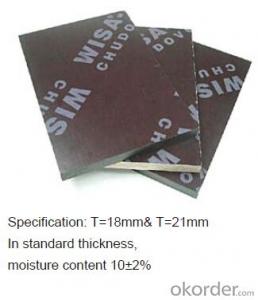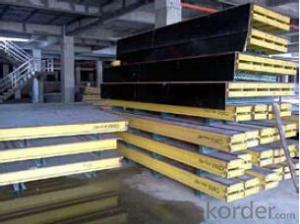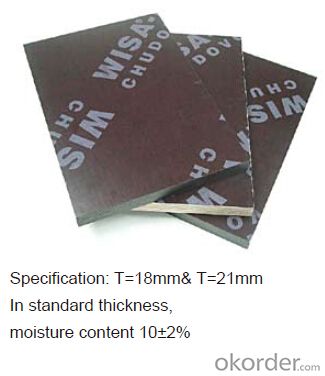Plywood Formwork System for Formwork and Scaffolding
- Loading Port:
- Tianjin
- Payment Terms:
- TT OR LC
- Min Order Qty:
- 50 g/m²
- Supply Capability:
- 1000 g/m²/month
OKorder Service Pledge
Quality Product, Order Online Tracking, Timely Delivery
OKorder Financial Service
Credit Rating, Credit Services, Credit Purchasing
You Might Also Like
Plywood --- make perfect concrete surface
WISA-Form Birch is a coated special plywood using in the formwork systems where high
requirements are set on the concrete surface and the times of reuses.
With CNBM timber beam & WISA plywood, the formwork is low weight but high load capacity, it is
widely used in construction.
Characteristics:
◆ Component with high standardization.
◆ Assembling in site, flexible application.
◆ Light weight, easy transportation and storage.
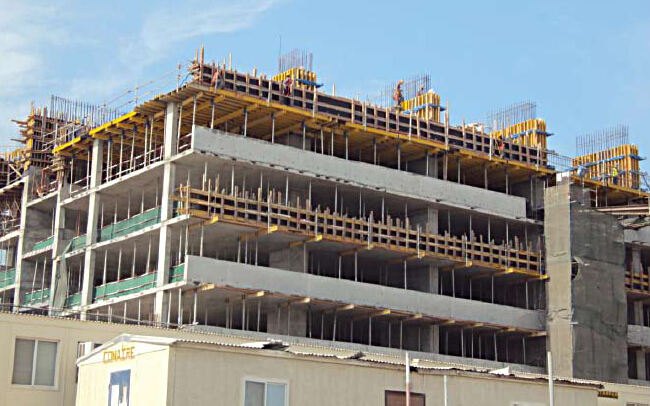
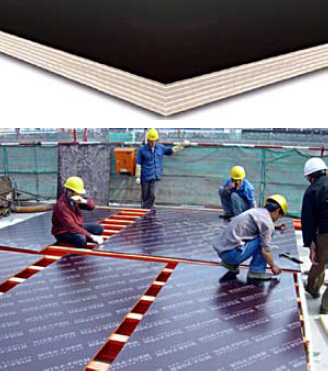
- Q: What are the different types of finishes applied to steel formwork surfaces?
- There are several types of finishes that can be applied to steel formwork surfaces. These finishes are designed to enhance the appearance, durability, and performance of the steel formwork. Some of the most common types of finishes include: 1. Galvanized Finish: This is a popular finish for steel formwork surfaces. It involves coating the steel with a layer of zinc, which provides excellent corrosion resistance. Galvanized finishes are often used in outdoor or high-moisture environments. 2. Powder Coating: Powder coating is a process in which a dry powder is electrostatically applied to the steel surface and then cured under heat. This results in a hard, durable finish that is resistant to chipping, scratching, and fading. Powder coatings are available in a wide range of colors and textures. 3. Paint Finish: Paint finishes are commonly used to enhance the aesthetics of steel formwork surfaces. They provide a smooth, uniform appearance and can be customized to match specific color requirements. Paint finishes also provide a level of protection against corrosion and weathering. 4. Epoxy Coating: Epoxy coatings are known for their excellent chemical resistance and durability. They are often used in industrial applications where the steel formwork may come into contact with chemicals, acids, or solvents. Epoxy coatings also offer good adhesion and abrasion resistance. 5. Anodized Finish: Anodizing is a process in which a layer of aluminum oxide is formed on the surface of the steel formwork. This finish provides enhanced corrosion resistance, as well as a decorative appearance. Anodized finishes are commonly used in architectural applications. 6. Stainless Steel Finish: For some steel formwork applications, a stainless steel finish may be preferred. Stainless steel is inherently corrosion-resistant and has a sleek, modern appearance. It is often used in environments with high humidity or exposure to chemicals. These are just a few examples of the different types of finishes that can be applied to steel formwork surfaces. The choice of finish will depend on factors such as the intended use of the formwork, the desired aesthetics, and the environmental conditions it will be exposed to.
- Q: How does steel formwork handle different concrete air content requirements?
- Steel formwork is a durable and versatile construction material that can effectively handle different concrete air content requirements. Concrete air content refers to the amount of air trapped within the concrete mixture, which is crucial for various reasons such as improving workability, durability, and resistance to freezing and thawing cycles. Steel formwork is designed to provide a strong and rigid structure to contain and shape the concrete during the pouring and curing process. Since the formwork is made of steel, it is not permeable, meaning it does not allow air to pass through. This prevents any air from escaping the concrete mixture, ensuring that the desired air content is maintained. To handle different concrete air content requirements, steel formwork can be customized or adjusted accordingly. For instance, if a higher air content is required, the formwork can be designed with additional space or voids to accommodate the desired amount of air within the concrete. On the other hand, if a lower air content is needed, the formwork can be designed to minimize any potential air entrapment by ensuring tight connections and smooth surfaces. Additionally, steel formwork can also be used in conjunction with other techniques to control the air content in concrete. For example, the formwork can be combined with the use of air-entraining admixtures, which are additives that are mixed with the concrete to purposely introduce air bubbles. These admixtures create a more uniform distribution of air throughout the concrete, and the steel formwork helps to retain this air during the pouring and curing process. In summary, steel formwork is well-suited for handling different concrete air content requirements due to its impermeability and customizable nature. It provides a reliable and robust structure to contain the concrete while ensuring that the desired air content is maintained, either by creating additional space for higher air content or by minimizing air entrapment for lower air content. Additionally, it can be used in conjunction with other techniques such as air-entraining admixtures to further control the air content in concrete.
- Q: What is the maximum concrete pressure that steel formwork can withstand?
- The maximum concrete pressure that steel formwork can withstand varies depending on several factors, including the specific design and construction of the formwork system. However, in general, steel formwork is capable of withstanding higher concrete pressures compared to other types of formwork materials. The maximum concrete pressure that steel formwork can withstand typically ranges from 50 to 100 kilonewtons per square meter (kN/m²) or 7.2 to 14.4 pounds per square inch (psi). This level of pressure is well-suited for a wide range of construction projects, including high-rise buildings, bridges, and other structures that require heavy concrete pours. It is important to note that the maximum concrete pressure that steel formwork can withstand should always be determined by a qualified engineer or designer. They will consider factors such as the height and thickness of the concrete pour, the spacing and size of the formwork supports, and the strength and stability of the steel formwork system. By adhering to the recommended maximum concrete pressure limits, construction professionals can ensure the safety and integrity of the formwork system, minimize the risk of failure or collapse, and achieve a successful concrete pour.
- Q: Types of building templates? What is clear water template?
- Wood plywood (water templates): currently widely used in the solid wood plywood formwork, should promote the use of wood covered plywood. Commonly used in Guangdong area of Eucalyptus wood membrane.
- Q: What are the common safety guidelines when working with steel formwork in confined spaces?
- To ensure the well-being of workers involved in working with steel formwork in confined spaces, it is crucial to adhere to specific safety guidelines. Consider the following commonly recommended safety measures: 1. Thoroughly assess risks: Prior to commencing work in a confined space, it is imperative to evaluate potential hazards and risks associated with the task at hand. This evaluation should encompass the identification of dangers such as inadequate ventilation, limited access, or the presence of hazardous gases. 2. Ensure sufficient ventilation: Confined spaces often lack proper air circulation, which can result in the accumulation of toxic gases or oxygen deficiency. Before entering, verify that the area is adequately ventilated, and continuously monitor air quality throughout the task. 3. Utilize suitable personal protective equipment (PPE): Workers must always wear the appropriate PPE, which includes safety helmets, goggles, gloves, and respiratory protection as required. The specific PPE necessities may vary depending on the nature of the confined space and associated hazards. 4. Implement adequate lighting: Insufficient lighting in confined spaces can hinder visibility and compromise safety. To mitigate accidents, provide sufficient lighting to ensure clear visibility. 5. Establish proper entry and exit procedures: Clearly define entry and exit procedures for workers entering and exiting confined spaces. This should involve the use of appropriate signage, secure barriers, and the assignment of a responsible individual to monitor and control access. 6. Ensure effective communication: Establish a reliable communication system between workers inside and outside the confined space. This can be achieved through the use of two-way radios, hand signals, or other means of communication to prevent isolation and enable prompt assistance if necessary. 7. Regularly inspect equipment and formwork: Prior to commencing work, inspect the steel formwork and associated equipment for any damage or defects. Promptly address any issues to prevent accidents or structural failures. 8. Provide comprehensive training: Workers involved in working with steel formwork in confined spaces should receive thorough training on safety procedures, hazard recognition, emergency response, and proper equipment usage. Regular training updates should also be conducted to ensure workers remain knowledgeable about safety practices. 9. Establish an emergency response plan: Despite taking necessary precautions, emergencies can still occur. Develop an emergency response plan that outlines evacuation, rescue, and medical assistance procedures. Ensure all workers are familiar with the plan and conduct regular drills to practice these protocols. 10. Regularly review and update safety procedures: Continuously review and update safety procedures to incorporate new regulations, industry best practices, or lessons learned from previous incidents. Continuous improvement and monitoring of safety measures are vital to maintaining a safe working environment. Remember, working in confined spaces with steel formwork carries significant risks. By following these common safety guidelines and fostering a safety-conscious culture, the risk of accidents and injuries can be minimized, ensuring a safer working environment for all.
- Q: Can steel formwork be used in cultural or entertainment facility construction projects?
- Yes, steel formwork can be used in cultural or entertainment facility construction projects. Steel formwork offers several advantages such as durability, strength, and the ability to withstand heavy loads. These qualities make it suitable for constructing large and complex structures found in cultural and entertainment facilities, such as theaters, concert halls, museums, and stadiums. Additionally, steel formwork can be easily customized to meet the specific design requirements of these facilities, providing flexibility and efficiency in the construction process. Moreover, steel formwork is reusable, which can result in cost savings and reduced environmental impact. Overall, steel formwork is a viable option for cultural or entertainment facility construction projects due to its strength, durability, flexibility, and cost-effectiveness.
- Q: Can steel formwork be used in high-rise construction?
- High-rise construction can utilize steel formwork effectively. Steel formwork possesses numerous advantages that render it suitable for high-rise construction undertakings. The first advantage lies in its robustness and durability, enabling it to withstand the immense pressure exerted during concrete placement in towering structures. This characteristic ensures stability and rigidity, thereby guaranteeing the formwork's integrity throughout the construction process. Moreover, steel formwork exhibits versatility, allowing for easy customization to meet the specific demands of high-rise buildings. Its adaptability permits effortless adjustment and reconfiguration, accommodating diverse shapes and sizes, ultimately facilitating flexible and efficient construction. Additionally, steel formwork yields a smooth and superior finish on concrete surfaces, an essential attribute for high-rise edifices that necessitate aesthetic appeal. Furthermore, steel formwork possesses the advantage of reusability, thereby reducing overall construction costs. Unlike conventional timber formwork, steel formwork can be disassembled and reused multiple times, presenting a cost-effective solution for high-rise endeavors. This not only diminishes waste but also promotes sustainability within the construction industry. Lastly, steel formwork enhances safety during high-rise construction. Its strength and stability minimize the prospect of accidents and collapses, thereby cultivating a safer working environment for construction workers. To conclude, steel formwork is undeniably suitable for high-rise construction due to its strength, versatility, cost-effectiveness, and safety features. It stands as a dependable and efficient solution that caters to the unique requirements of towering structures.
- Q: How does steel formwork handle different concrete surface treatments?
- Steel formwork is known for its versatility and durability in handling different concrete surface treatments. Due to its strong and rigid structure, steel formwork can effectively withstand the pressure and weight of different concrete surface treatments without deforming or collapsing. Steel formwork is commonly used in construction projects that require various surface treatments, such as smooth, textured, or patterned finishes. The steel panels and frames provide a stable and rigid surface, ensuring that the concrete is poured and cured evenly. This helps to achieve a high-quality and consistent finish. Additionally, steel formwork can easily accommodate different types of surface treatments. For instance, if a project requires a smooth finish, the steel formwork can be polished or coated with a release agent to create a smooth surface. If a project requires a textured or patterned finish, the steel formwork can be specially designed or modified to incorporate the desired texture or pattern. This flexibility allows for creativity and customization in achieving the desired aesthetics. Furthermore, steel formwork can be reused multiple times, making it cost-effective and environmentally friendly. This means that it can handle different concrete surface treatments in various projects, providing consistent and reliable results each time. In summary, steel formwork is an excellent choice for handling different concrete surface treatments due to its strength, durability, and versatility. It can withstand the pressure and weight of various finishes, accommodate different types of surface treatments, and be reused multiple times, making it a reliable and cost-effective option in construction projects.
- Q: What are the different types of release agents used with steel formwork?
- There are several types of release agents used with steel formwork, including petroleum-based agents, water-based agents, silicone-based agents, and wax-based agents. These release agents are applied to the surface of the formwork to prevent the concrete from sticking to it during the pouring and curing process. Each type of release agent has its own advantages and suitability for different applications, depending on factors such as the desired finish, ease of application, and environmental considerations.
- Q: How does steel formwork handle different types of concrete mixes?
- When it comes to handling various concrete mixes, steel formwork proves to be a versatile and durable option. It can withstand the pressure and weight of different concrete mixes, making it suitable for both regular and specialized applications. The load-bearing capacity of steel formwork is commendable as it can handle heavy concrete mixes without any deformation or collapse. This feature becomes particularly crucial for concrete mixes with a high water-cement ratio or those containing additives like admixtures. Such additives can increase the fluidity and weight of the concrete, but steel formwork remains unaffected. Additionally, steel formwork is resistant to chemical reactions that may occur between certain concrete mixes and other materials. It can endure the alkaline nature of concrete, preventing any corrosion or degradation over time. This makes it feasible for handling concrete mixes that may have aggressive chemical compositions or contain aggressive substances such as sulfates or chlorides. Steel formwork also offers flexibility in terms of shape and size. It can be easily customized to accommodate different concrete designs and structures, allowing for the creation of complex shapes and architectural features. This versatility makes steel formwork suitable for handling concrete mixes used in modern construction, where unique and intricate designs are often desired. Moreover, steel formwork provides a smooth and consistent finish to the concrete surface. This proves to be particularly advantageous for concrete mixes that require a high-quality finish, such as those used in architectural applications or exposed concrete structures. The smoothness of the steel formwork surface helps in achieving a visually appealing and structurally sound concrete finish. Overall, steel formwork is an ideal choice for handling various types of concrete mixes. Its strength, resistance to chemical reactions, flexibility, and ability to provide a smooth finish ensure the integrity and quality of the concrete structure. It proves to be a reliable and efficient solution for construction projects of all sizes and complexities.
Send your message to us
Plywood Formwork System for Formwork and Scaffolding
- Loading Port:
- Tianjin
- Payment Terms:
- TT OR LC
- Min Order Qty:
- 50 g/m²
- Supply Capability:
- 1000 g/m²/month
OKorder Service Pledge
Quality Product, Order Online Tracking, Timely Delivery
OKorder Financial Service
Credit Rating, Credit Services, Credit Purchasing
Similar products
Hot products
Hot Searches
Related keywords
